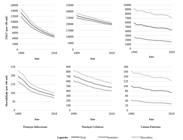Abstract
In 2020, the 30th anniversary of the publication of the Organic Laws of the Unified Health System was celebrated. Since then, the change in the profile of morbidity and mortality has been a challenge to management to ensure that the health services can attend the significant heterogeneity of approximately 6,000 municipalities. To achieve this, it is necessary to monitor the leading indicators of the country. The scope of this study was to present an overview of trends in mortality and morbidity in Brazil between 1990 and 2019. Data from the Study on the Global Burden of Disease was used to describe morbidity and mortality by major groupings (infectious diseases, chronic diseases, and external causes), according to gender and age groups. There was a reduction in morbidity and mortality in the period, irrespective of the cause or age group, albeit with a varied difference between the sexes depending on the cause. The contribution of chronic diseases increases with age, with a marked difference according to gender. The curves for mortality and years lost due to disability have a typical profile, with a different pattern of curves for men due to external causes, with marked excess mortality at young ages. The trend confirms the decline of indicators in a linear manner over the period.
Key words:
Health transition; Cause of death; Demographic analysis; DALY; Mortality

 Thumbnail
Thumbnail
 Thumbnail
Thumbnail
 Thumbnail
Thumbnail
 Thumbnail
Thumbnail
 Fonte: GBD, 2021.
Fonte: GBD, 2021.
 Fonte: GBD, 2021.
Fonte: GBD, 2021.
 Fonte: GBD, 2021.
Fonte: GBD, 2021.
 Fonte: GBD, 2021.
Fonte: GBD, 2021.